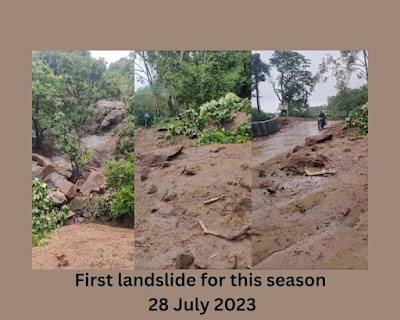June: A Month of Scorched Hopes
In June, people hear the first whispers of the monsoon, igniting a sense of hope. But this year, even the fervent “havans” and prayers to the rain gods couldn’t shift the tides of fate. While it’s said that prayers can move mountains and summon rain, here, the sun remained unforgiving, scorching the mountainside with relentless heat.
Before: because of the lack of water, the young trees planted the previous year, meant to revive the landscape, withered away. The once-vibrant greenery that adorned the hills vanished, leaving behind a dry, desolate scene. The trees, once symbols of resilience, stood lifeless and brittle.
Abu has endured many tough years, but none felt as dreadful as this one. June, with all its promises, became a month of disappointment and despair.
JULY:-
July: A Sigh of Relief
The long-awaited monsoons arrived in July, though they made us wait until the 24th. The residents of this mountain retreat were on edge, their uneasiness noticeable. Day after day, we watched the skies, hoping for the dark clouds to roll in and deliver the rains that would revive the land and our spirits.
When the rains fell, it was as if the entire hill station heaved an enormous collective sigh of relief. The tension that had built up over the months melted away as the parched earth drank in the life-giving water. It was a moment filled with deep gratitude and hope, assuring us that better times were coming.
AUGUST:-
The Return of Life and a Short-Lived Victory.
The rain gods had mercy on Mount Abu, blessing this parched hill station with the much-needed downpour. The better-than-average monsoon quenched the dry earth, bringing life back to the hills. With the arrival of the rains, the town returned to normal and businesses thrived once more. The air was filled with a renewed sense of hope as the vibrant greenery reemerged.
For a short time, another victory was celebrated — the news that Rajasthan, and especially Mount Abu, had committed to going plastic-free for better environmental protection. This was the talk of the town. The threat of hefty fines and even imprisonment led to the swift disappearance of plastic bags from the shelves. Overnight, paper and cloth bags made their way into the hands of shoppers.
But this victory was short-lived. With no real follow-up plans or enforcement, the reliance on plastic bags soon crept back into everyday life. The initial enthusiasm faded, and the town once again found itself dependent on the very thing it sought to eliminate. It was a reminder that lasting change requires more than just a momentary push — it needs sustained effort, commitment, and the will to see it through.
SEPTEMBER:-
September: The Month of Festivals and Gathering of the Gods
September in Mount Abu is a vibrant month, filled with festivals and celebrations. Every year, the town puts on its annual marathon, a long-standing custom that brings together both locals and tourists. Mother Nature lays out lush green carpets and refreshing rain drenches the hills, welcoming visitors during the peak of the monsoon season. It’s the perfect time for tourists to experience the beauty of this “Abode of the Gods” in its most breathtaking form.
For me, September holds a special place in my heart. It’s the month Liz celebrates her birthday, and I cherish these moments spent with her. I also have a deep love for the monsoon months; they grant me the freedom to explore this hill station in the environment I adore — surrounded by rain-soaked forests, misty vistas, and the ever-present hum of nature.
TOBER:-
October: The Perfect Time to Be in Abu
October is the month to be in Mount Abu. At this time of year, the hill station is at its most beautiful. The hills are draped in every imaginable shade of green, a vibrant tapestry that blends with the clear skies and cool breezes. The temperature is perfect — neither too hot nor too cold — creating an atmosphere that invites you to step outside and enjoy the outdoors.
It’s a time for fun, frolicking, and soaking in the serene beauty that surrounds us. October in Abu is a season of pure joy, the ideal time to embrace everything this hill station offers.
The Annual School Fete for the pleasure of the visiting parents and students
NOVEMBER:-
The Diwali season went off extremely well. Thousands of tourists thronged the streets and haunts of Abu. The spectre of drought that was hanging only a few months ago was now a thing of the past.
I can’t recall Abu having continuous rain in November for almost an entire week. This unprecedented rainfall caused a mini imbalance in this Eco-zone, the birds, bees and animals were thrown off balance. This extraordinary show of the rain gods also put the human population out.
DECEMBER:-

December: A Month of Frost and Festivities
December in Mount Abu begins with a flurry of activity for school-going students as they wrap up their final examinations. It’s a hectic time, but once the exams are over, they head home for a well-deserved winter vacation — three full months of rest and freedom.
The mornings embrace us with a familiar visitor, Mr. Frost, coating the landscape in a thin, icy sheen. Daytime temperatures remain pleasant, but the chill deepens with the sun’s descent, and the mercury dips between +3 to -3 degrees on many nights. The frosty darkness reminds us that winter is here.
As time flies, I am eager to get my last message out before midnight.
”Merry Christmas, Folks!”
Kalá Hristúyenna, Merry Christmas and Joyful New Year, शुभ क्रिसमस, Buon Natale e Felice Anno Nuovo.
Wishing you all a magical festive season filled with love, warmth, and beautiful thoughts. I want to take this moment to express my heartfelt gratitude for all your support and kind wishes throughout the year 2010.
“Merry Christmas!”

Bosky, my beloved basset

























